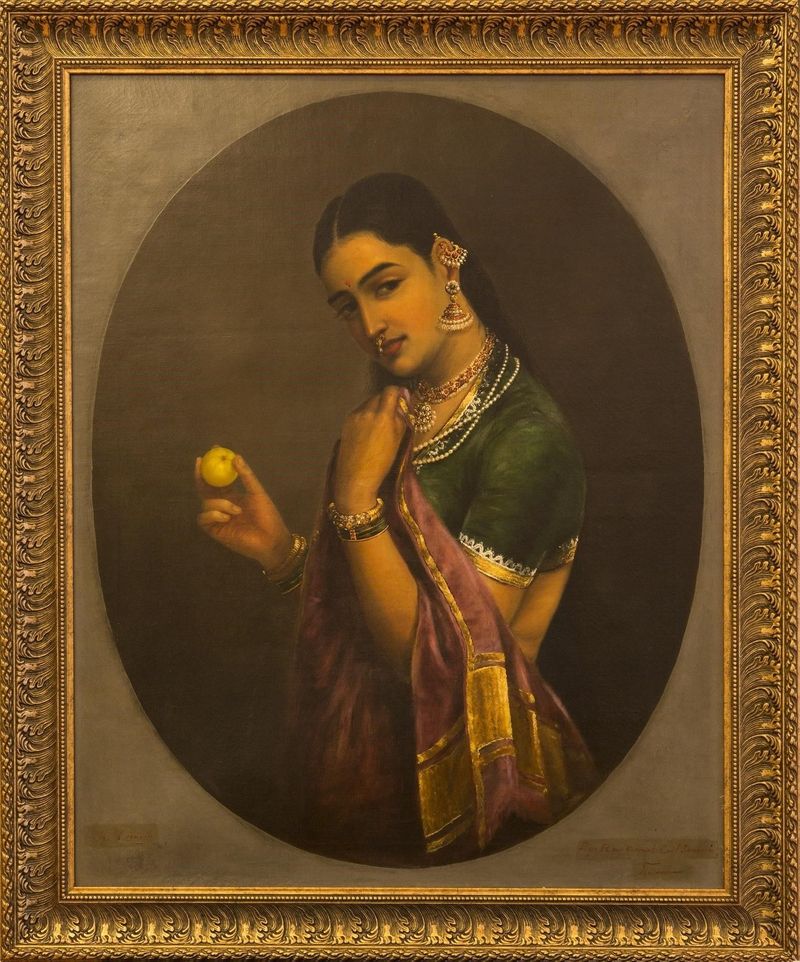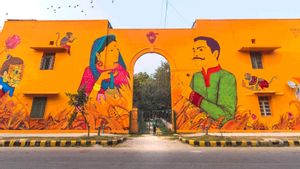As a little boy, Ravi Varma would draw on the blank walls of the family house using charcoal pieces from the kitchen. His uncle Raja Raja Varma, an artist and scholar, saw his potential and encouraged him to continue drawing.
Ravi Varma's body of work has played a crucial part in the culture and landscape of Indian art. While these amazing works of brilliance have been appreciated and revered over the years in India, the works are restricted from exports outside the country, as they are considered national treasures.
Ravi Varma was known for painting beautiful women. While he was equally recognised for painting mythological subjects and gods and goddesses, two pieces from his body of work—The Coquette (below) and Reclining Nair Lady (in the banner)—are the most popular and recognisable artworks by the great painter to be considered as NFTs.

Rukmini Varma, chairperson of the Raja Ravi Varma Heritage Foundation and an octogenarian artist who is the great-great-granddaughter of the master painter says: “Most of what I know of my great-great-grandfather’s life, of him as a person and an artist, I have penned in my book Hidden Truth. I have always lived by his ideals and have done my best to keep his legacy alive. As an artist, I follow a similar style of work, paint with a similar palette of colours, yet maintain originality in my work. I paint only based on my imagination and what I visualise in my mind’s eye. Ravi Varma painted using his imagination, but he based his works on reality. That is why, unlike his paintings, you will see figures and subjects in my work that are more unreal and very different from what he painted. I am as excited about this NFT auction as others seem to be. It’s a new concept for me and I am eager to see how it pans out.”
An artist herself, Rukmini’s memories of Ravi Varma came from the stories that she heard from her great grandmother. The book she authored has been a result of notes she found in Raja Ravi Varma's writing many decades ago. Ravi Varma’s paintings were all about infusing life through colours. That was a result of his close observation of nature. His works exemplify the fusion of European academic art with Indian sensibilities and iconography. He was known to increase his reach with the public by making affordable lithographs of his paintings.
Digitising Raja Ravi Varma’s legacy
Vinita Angelo, COO/Co-Founder, RtistiQ says, “This collection of works of Raja Ravi Varma will be the first-ever to be tokenized and launched, accepting payments via credit card and crypto. At the same time, it is the first time an NFT auction has been held in partnership with a traditional gallery as well as with an artist Foundation i.e. Gallery G and the Raja Ravi Varma Heritage Foundation.”
These are also one of the two works discovered and handled by Gallery G for the owner (who continues to own the two physical paintings to date) and taken to Raja Ravi Varma Heritage Foundation for restoration and documentation. In 2021, Gallery G had also shown these two works in one of the largest exhibitions it ever hosted, ‘Masters and Modern’, and generated massive response.

NFTs are rapidly entering the mainstream; they are non-fungible, meaning they cannot be exchanged and hold a unique representation. “NFT markets are inherently more open than their traditional counterparts. Since NFTs are built on fully public blockchain infrastructure, most transaction data is publicly available which makes it transparent, so you know what you are getting is legit and the real deal. Several factors gauge the NFTs' worth such as rarity, utility, and tangibility,” says Angelo.
Once someone bids and acquires NFTs, they can resell the works on our marketplace which will be extended for collectors to display and resell the works. Also, the holders can place the NFTs in other compatible marketplaces including OpenSea using their wallets. “We support Torus and MetaMaskas non-custodial wallets to hold NFTs for the collectors attached to any NFT Marketplace and trade the artworks further,” says Angelo.

Raja Ravi Varma Heritage Foundation and Gallery G have been consistently working towards preserving and promoting the artistic legacy of the great artist. Gitanjali Maini, founder-director, gallery g says: “It was synergistic in every sense to collaborate and bring together the NFTs for his body of works as an extension to his own legacy of establishing a printing press, which garnered wide popularity across elites and middle-class homes. We maintain strong relations with many private collectors who own the artist’s work.” The present owner of these two works acquired them in the late 1970s or early 1980s and they have remained with the family ever since. They do not have any intention of ever selling these works and that’s why we felt they needed to be part of this historic first NFT drop. These paintings have clear documentation and have been mentioned by C Raja Raja Varma, the younger brother of Raja Ravi Varma, in his diary that has been edited and compiled by Austrian scholar, archaeologist, ethnologist and anthropologists Erwin Neumayer and Christine Schelberger. There is no further information on their provenance.
Gallery G was approached by the owner through common friends for assistance with regard to restoration. “We even showed the paintings twice - once at the Kerala Museum in Kochi 2019 during an outreach event (Ravi Varma and his Contemporaries) and in February - March 2021 during ‘Masters and Modern’ in Bangalore at our gallery,” says Maini.
The NFT auction would be made accessible to everyone globally on RtistiQ's website.




